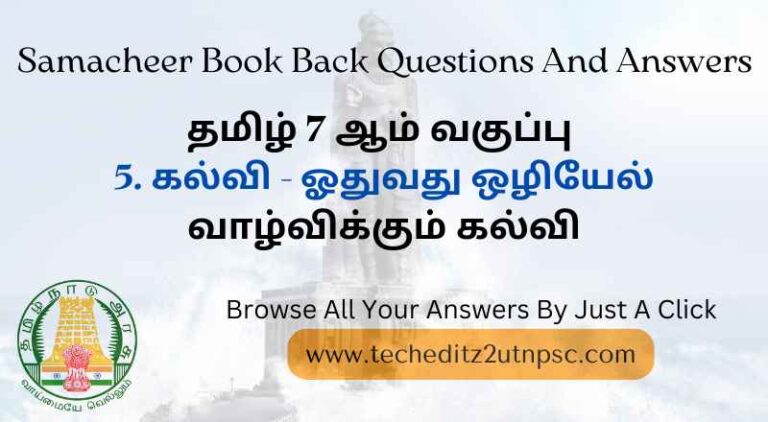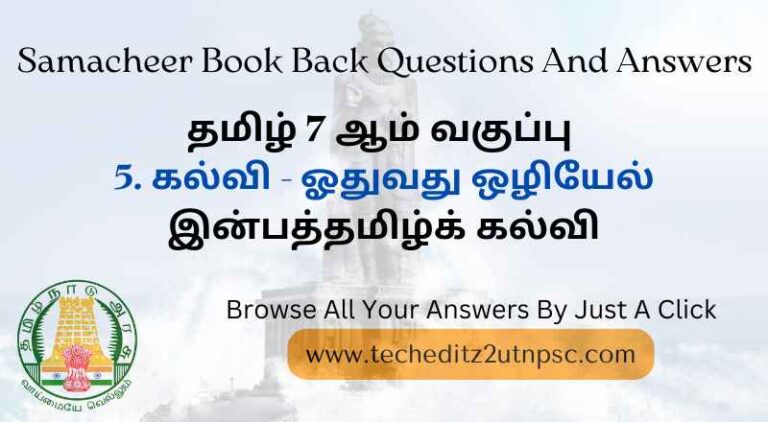support@techeditz2utnpsc.com | 8300-921-521
Forms Of Government And Democracy
Samacheer Book Back Questions And Answers For Indian Polity Standard 9 Full Book “Forms Of Government And Democracy”
I. Choose the correct answer:
1. A system of government in which one person reigns supreme, usually a king or queen, is called _____
(a) autocracy
(b) monarchy
(c) democracy
(d) republic
2. A system of government by one person with absolute power.
(a) Aristocracy
(b) Theocracy
(c) Democracy
(d) Autocracy
3. When a country is governed by a few privileged, the form of government is called _____
(a) Aristocracy
(b) Parliamentary
(c) Democracy
(d) Republic
4. Former Soviet Union is an example for _____
(a) aristocracy
(b) theocracy
(c) oligarchy
(d) republic
5. Select the odd one _____
(a) India
(b) USA
(c) France
(d) Vatican
6. Abraham Lincoln was the President of the
(a) USA
(b) UK
(c) USSR
(d) India
7. Kudavolai system was followed by _____
(a) Gheras
(b) Pandyas
(c) Cholas
(d) Kalabhras
8. Direct Democracy in olden times existed _____
(a) In the republics of ancient India
(b) Among the USA
(c) In the city-state of ancient Athens
(d) Among the UK
9. In which country has democracy originated?
(a) India
(b) Switzerland
(c) USA
(d) Athens
10. From which language was the term “Democracy” derived?
(a) Greek
(b) Latin
(c) Persian
(d) Arabic
11. In democracy the final authority rests with _____
(a) The Parliament
(b) The People
(c) The council of Ministers
(d) The President
12. Which one of the countries has Presidential form of government?
(a) India
(b) Britain
(c) Canada
(d) USA
13. The largest democratic country in the world is ¬¬¬¬_____
(a) Canada
(b) India
(c) USA
(d) China
14. Assertion (A): Direct democracy is practised in Switzerland.
Reason (R): People directly participates in decision making.
(a) Both (A) and (R) are true and (R) explains (A)
(b) Both (A) and (R) are true and (R) does not explain (A)
(c) (A) is correct and (R) is false
(d) (A) is false and (R) is true
15. Assertion (A): India has parliamentary form of democracy.
Reason (R): Indian parliament comprises two houses.
(a) Both (A) and (R) are true and (R) explains (A)
(b) Both (A) and (R) are true and (R) does not explain (A)
(c) (A) is correct and (R) is false
(d) (A) is false and (R) is true
16. The meaning of Franchise is _____
(a) Right to elect
(b) Right to vote for the poor
(c) Right to vote
(d) Right to vote for the rich
17. The grant of universal franchise creates _____
(a) Social equality
(b) Economic equality
(c) Political equality
(d) Legal equality
18. Prime Minister of India is appointed by _____
(a) Lok Sabha
(b) Rajya Sabha
(c) Speaker
(d) President
19. The President of India can nominate _____
(a) 12 members to Lok Sabha
(b) 2 members of Rajya Sabha
(c) 12 members to Rajya Sabha
(d) 14 members of Rajya Sabha
20. The First general elections after independence in India were held in _____
(a) 1948
(b) 1952
(c) 1957
(d) 1947
II. Fill in the blanks:
1. The Constitution of India was finally adopted on _____
2. The two types of democracy are _____ and ¬¬¬_____
3. An example for direct democracy is _____
4. India has a _____ form of democracy.
5. _____ was the first Prime Minister of independent India.
6. The first general elections were held in British India in the year _____
7. The Parliament House in India was designed by _____ and _____
Answers:
1. 26th November 1949
2. Direct and Indirect
3. Switzerland
4. Parliamentary
5. Jawaharlal Nehru
6. 1920
7. Edwin Lutyens and Herbert Baker
III. Match the following:
1. Autocracy A. 18
2. Right to vote B. Arthashastra
3. Chanakya C. Vatican
4. Theocracy D. North Korea
Answers:
1. D
2. A
3. B
4. C


